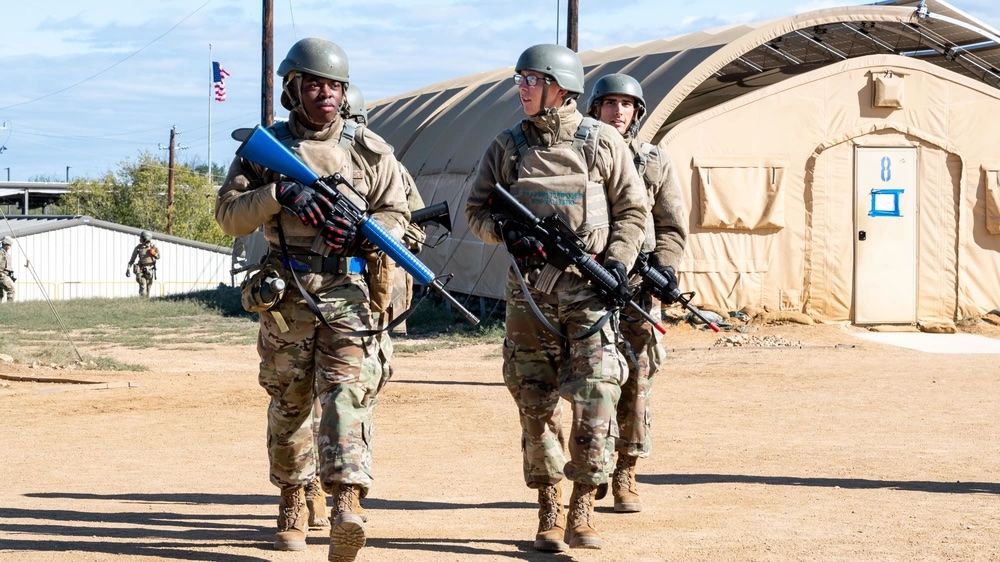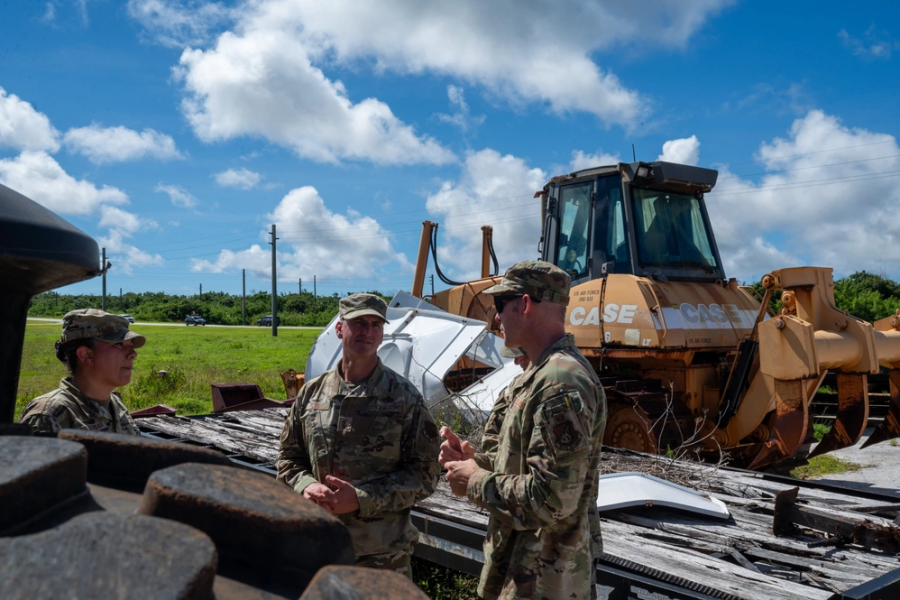A group of the USAF’s top enlisted leaders learned an important lesson during an exercise in the Pacific earlier this year: don’t take cover next to a fuel tank.
Chief Master Sergeant of the Air Force David A. Flosi and about 30 other chief master sergeants were practicing a technique called Agile Combat Employment, where Airmen launch and recover aircraft from small, dispersed airfields. ACE is meant to reduce the chances of being targeted by a long-range missile, but the small teams mean Airmen have to pull security, refuel aircraft, load cargo, and other tasks outside their usual job specialties.
Flosi and the other chiefs “lived ACE for about a week” somewhere in the U.S. Indo-Pacific Command area of responsibility, he said on a Nov. 23 episode of his interview series, “The Enlisted Edge.” Each of them had more than 20 years of experience in the Air Force, but that didn’t save many from a deadly, though still simulated, miscalculation.
“Our first iteration of a contested environment … there were 30 chiefs in the group, and through the exercise scenario, we lost 22 of them,” he said. “It turns out it’s not a good idea to go take cover right next to a 20,000 gallon fuel tank.”
While Flosi was not one of them, he noted how the circumstances pushed most of the chiefs to make the error. He and the other chiefs were trying to build a camp, establish communications, secure the area, and get an airfield going on a tight deadline to meet an incoming aircraft.
“And then you get an inbound [missile] and there’s no bunkers, this is not an improved airfield,” he said. “If you’ve not thought through all that in advance and you’re not making good risk decisions, you very easily can end up in a lethal situation.”
Indeed, risk management was the key topic of the interview, where Flosi spoke with Maj. Gen. Sean M. Choquette, commander of the Air Force Safety Center, and Chief Master Sgt. Amber Person, the center’s chief enlisted manager, about a new strategy to spread better risk management tools across the Air Force and Space Force.
Announced in August, the Integrating Risk and Readiness campaign aims to bake risk management principles into all training, career fields, and operational environments so that Airmen are better prepared both at home and in an ACE environment. The campaign complements a new Air Force Safety Center strategic plan unveiled in April.
Choquette wants to flip the status quo, where one Air Force safety specialist or squadron flight safety officer might be the risk management guru for an entire flight line.
“We’re really talking specifically about risk management and getting that skill set out there,” he said in the interview. “So it’s not a safety professional walking onto the flight line saying ‘hey, let’s look at these things.’ It literally is Airmen walking around their flight line or their operations area, their personnel office, the front gate, you name it, and saying ‘hm, is there a better way to do this?’”
The strategic plan is sparse on specific tools and training, but its goals include formalizing safety principles and risk management as core competencies, conducting a public affairs campaign to refocus on those concepts, conducting a six-month evaluation to figure out where risk management needs to align with future operations, then developing an implementation plan to bridge the gaps. The idea is for the risk management principles to be widespread across training and periodically reassessed.
While the specifics are still in development, Choquette and Person hinted at what it could look like. One example is in aviation career fields, where crews brief, debrief, and perform other formal risk management practices as a matter of course. That isn’t to say HVAC specialists, for example, need to adopt the same formal practices, but the Safety Center hopes to spread a similar kind of mindset.
“The assumption is ‘OK, so before I go out this weekend, do you want me to sit down and draw out the five-step process with my friends?’ And that’s not realistic, and no that’s not what we’re expecting,” said Person. “You do risk management when you are backing out of your driveway in the morning. You check to make sure that the bike’s not behind you, or the dog’s not running around, or whatever it might be before you actually back up. As simple as that seems, it’s not always that easy to do or to be mindful of.”
Every job in the Air Force and Space Force has lengthy regulations and instructions on how to do that job safely, Person said, but somewhere there is a disconnect where Airmen or Guardians get complacent or skip steps and introduce more risk.
“If we just try to implement more of that risk mindset of ‘OK I’m going back out of my driveway, I’m going to look behind me before I do so,’ with everything that we do, I think that we’ll be better for it,” she said.
Another example is “knock it off,” a phrase aviators use during an exercise to stop what they’re doing, return to level flight, and reassess. A third is promoting a culture where junior Airmen are empowered to address risk management issues.
“That’s that skill set … as they’re going through operations, can somebody in the team, whether it’s the senior person or not, can say ‘stop, knock it off for a minute,’” Choquette said. “Every day we do this, but if we can train to it and assess to it, it will just become a part of our DNA and how we operate.”
Those skills may not be new to operations and maintenance, Flosi said, but the idea is to enhance it in those fields and spread it to others.
“We’re going to up our operational IQ there and then we’re bringing it into the rest of the force that doesn’t have that,” he explained. “A lot of our support forces do, but not all.”

The hope is that expanding the mindset will bring down noncombat fatalities: fiscal year 2023 saw the deaths of 49 Airmen and Guardians, while 2024 saw the deaths of 42, Choquette said, though he did not specify if those were all due to safety mishaps. FY23 also saw two people die and 10 aircraft destroyed in a five-year high for aviation-related mishaps. That’s a tragedy and a loss of combat power, officials said.
“We don’t have spare Airmen,” Flosi said. “In order for us to be lethal and capable, we’ve got to eliminate unforced errors.”
Data could also help: another part of the strategic safety plan is to use artificial intelligence to analyze the center’s 40 years of data and forecast where the next mishap might occur.
“We’re going to have some real analytical rigor through some AI algorithms to say … ‘this is where we kind of know it’s going to happen,’ and here are some things, commander and chief, that you can do to maybe prevent that,” Choquette said.
In the meantime, the general promised that the safety center will create “some toolsets” to help Airmen and Guardians manage risk in the near future.
“We owe them that and the safety enterprise is working on some things,” he said. “This isn’t just talk.”
Editor’s Note: This story was updated Dec. 2 to correct details about the exercise involving Chief Master Sergeant of the Air Force David A. Flosi.
